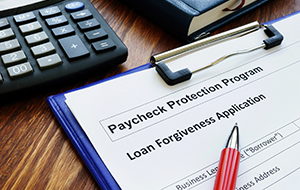In late 2020, the IRS announced that it will increase tax audits of small businesses by 50 percent in 2021. Here are several mistakes to avoid if you do get audited by Uncle Sam.
- Mistake: Missing income. A long history of investigating has led IRS auditors to focus on under-reported income. If you’re a business that handles cash, expect greater scrutiny from the IRS. The same is true if you generate miscellaneous income that’s reported to the IRS on 1099 forms. Be proactive by tracking and documenting all income from whatever source. Invoices, sales receipts, profit and loss statements, bank records—all can be used to substantiate income amounts.
- Mistake: Higher than normal business losses. Some small businesses struggle in the early years before becoming profitable. If your company’s bottom line never improves, the IRS may view your enterprise as a hobby and subsequently disallow certain deductions. As a general rule, you must earn a profit in three of the past five years to be considered a legitimate business.
 Mistake: Deductions lacking substantiation. Do you really use your home office exclusively for business? Does your company earn only $50,000 a year but claim charitable donations of $10,000? Do you write off auto expenses for your only car? The key to satisfying auditors is having clear and unequivocal documentation. They want source documents such as mileage logs that match the amount claimed on your tax return and clearly show a business purpose. If you can’t locate a specific record, look for alternative ways to support your tax return filings. In some cases, a vendor or landlord might have copies of pertinent records.
Mistake: Deductions lacking substantiation. Do you really use your home office exclusively for business? Does your company earn only $50,000 a year but claim charitable donations of $10,000? Do you write off auto expenses for your only car? The key to satisfying auditors is having clear and unequivocal documentation. They want source documents such as mileage logs that match the amount claimed on your tax return and clearly show a business purpose. If you can’t locate a specific record, look for alternative ways to support your tax return filings. In some cases, a vendor or landlord might have copies of pertinent records.- Mistake: No expense reports. If you use your credit card for business, create an expense report with account numbers and attach it to each statement. Then attach copies of the bills that support the charges. This is an easy place to blend in personal expenses with business expenses and auditors know it.
- Mistake: No separate books, bank accounts or statements. Never run personal expenses through business accounts and vice versa. Have separate bank accounts and credit cards. A sure sign of asking for trouble is not keeping the business separate from personal accounts and activities.
- Mistake: Treat the auditor as an enemy. Auditors have a job to do, and it’s in your best interest to make their task as painless as possible. Try to maintain an attitude of professional courtesy. If you’re called to their office, show up on time and dress professionally. If they come to your place of business, instruct staff to answer questions honestly and completely.
Here are some suggestions to help you master the art of documenting and organizing your business now and in the future.
- Document policies and procedures. Write down daily responsibilities, skills needed to complete tasks related to these responsibilities, and the location of all paper and electronic files. Appoint and cross-train backup staff to ensure these daily tasks are done.
- Document your succession plan. It may not be for another 10 or 20 years, but documenting your succession plan is critical for both you as the owner and for your employees. Consider how much longer you plan on owning the business and who you have in mind to take over after you leave. If you currently don’t have a successor in mind, document your plan to either train or find this person(s).
- Document your tax planning strategy. Be aware of possible tax incentives, such as credits for hiring certain workers and accelerated depreciation available for acquiring business assets. For example, for asset purchases, retain receipts and record the purchase details. These details include the type of equipment, the acquisition date, the amount of the purchase, the date you began using the equipment, and a schedule of related set-up costs.
- Organize your daily documents. Organize your desk by shredding documents with sensitive information and scanning older papers into computer files. The most efficient method is to scan, file, and shred as soon as you are finished with a document. If you don’t have time, consider assigning document organization to specific employees and making it a task to be completed on a daily basis.
 You’re busy, and you may feel that organizing your records will take more time than you have available. But spend a minute and consider how using these organizational tips may save you not only time, but money as well.
You’re busy, and you may feel that organizing your records will take more time than you have available. But spend a minute and consider how using these organizational tips may save you not only time, but money as well.
 More than 70% of small businesses in America now have loan proceeds from the Paycheck Protection Program (PPP) to help retain employees during the current pandemic. The entire amount of a PPP loan is eligible to be forgiven if the funds are used for qualified expenses. Recent legislation liberalizes the terms of loan forgiveness for funds used for payroll, utilities and rent. It is now based on a 24-week period, not just eight weeks.
More than 70% of small businesses in America now have loan proceeds from the Paycheck Protection Program (PPP) to help retain employees during the current pandemic. The entire amount of a PPP loan is eligible to be forgiven if the funds are used for qualified expenses. Recent legislation liberalizes the terms of loan forgiveness for funds used for payroll, utilities and rent. It is now based on a 24-week period, not just eight weeks.
But how can you best position your company to fully benefit from PPP loan forgiveness? Here are five tips to help meet the challenge.
- Restore your staff. If possible, restore the number of full-time equivalent (FTE) employees to previous levels by the safe-harbor due date of December 31 (extended from June 30). Bring back furloughed FTEs as soon as you can. Of course, this should fit into your overall business plan. If an employee does not return, document the refusal. All these actions will help when the forgiveness formula is applied to your loan.
- Pile on payroll costs. Run payroll and other remaining qualified expenses—including mortgage interest, rent and utilities—on the last day of the 24-week period. This will enable your business to maximize the amount of loan forgiveness allowed under the calculation.
- Reward employees. Consider paying out reasonable incentive amounts to maximize the forgiveness of payroll costs. The bonuses can even go to family members like your spouse or children. But remember that you can only count up to $100,000 of wages per person, pro-rated for the covered year, and you must be able to defend these payments as reasonable.
- Use the simplified application form. There are two loan forgiveness forms – the regular form (Form 3508) and a simplified version called Form 3508EZ. Review both forms before deciding which one is right for your situation. For instance, there are fewer calculations on the simplified form with less documentation required. To qualify for the simplified form, you must meet at least one of these requirements:
- You’re self-employed and have no other employees.
- You didn’t reduce employee hours or reduce their wages and salaries by more than 25%.
- You lost business due to health directives relating to COVID-19 and didn’t reduce employee wages and salaries by more than 25%.
- Document everything. Once you receive PPP loan funds, keep supporting documentation on everything related to the loan. Document when you receive the loan, each time you spend part of the loan and accrued interest expense on the loan. Also keep copies of receipts and invoices to document all loan expenditures, including bank account statements and journal entries.